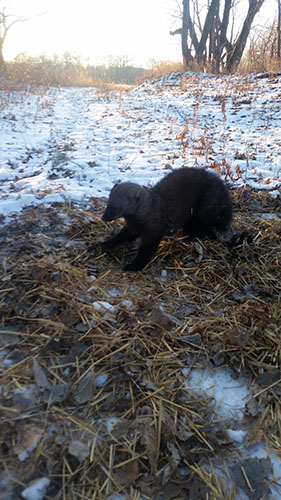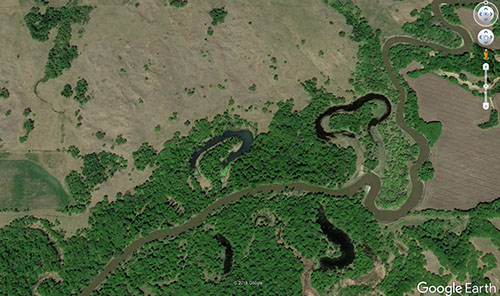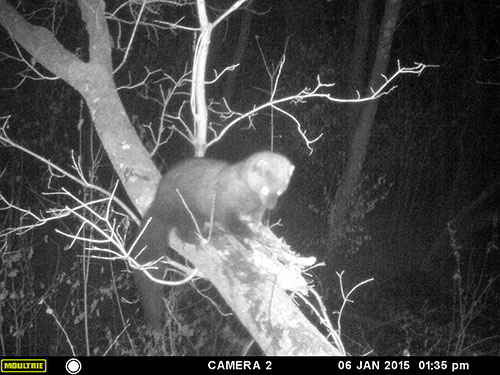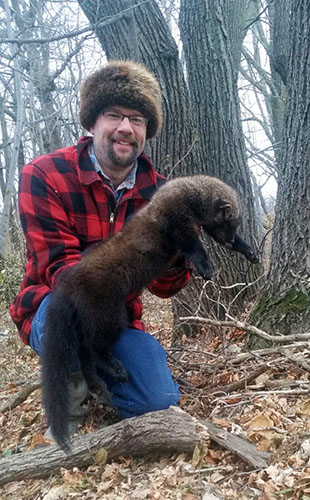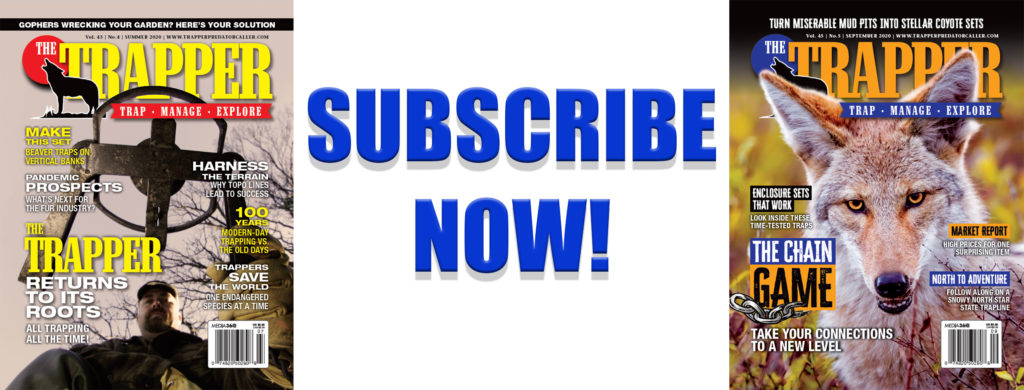The author finds big-woods furbearers in the wide-open West.
Text and photos by Jeffrey Miller
The late October morning was heartbreaking in its beauty. What started as a bruise on the eastern horizon grew into a gorgeous eruption of color, backed by a cerulean blue sky. With a slight breeze out of the northwest, even the movement of a deer mouse sounded like an elephant. Intently waiting for a deer, the flurry of motion to the east of my stand caused me to reach for my bow. What came into view was most definitely not a deer.
The low-slung black animal scurried through the river bottom. My first thought was a mink, but with a tail two feet long I knew that wasn’t the case. I was still pondering the sight when a buck cruised through the funnel and took my mind off of the mystery animal. The next few hours were spent getting that buck out of the woods and into my garage.
Back home, a quick Google search identified the animal as a fisher. The furtive loping of the animal made sense, as they are a member of the mustelid family. Digging deeper, I learned that North Dakota opened the first fisher trapping season in 2011. Game Department personnel hoped to learn more about the pioneering animals by studying the carcasses of those trapped in a very limited season. The first few seasons were operated on a quota system. Once the quota was reached the season shut down. In later years, the season has been opened for seven days, regardless of harvest. The season has proved to be very popular among the state’s trappers. In 2018, for instance, 38 fishers were registered during the open season.
I had just started to dabble in trapping. Successful on a couple raccoons, I had hopes of catching a coyote during the winter. Establishing a bait station was easy, as I had been successful on a late-season archery hunt. Shoulder blades and hip bones from the deer worked perfectly for bait, fastened to a couple of trees. Guarding the baits with trail cameras, I let them soak for a week.
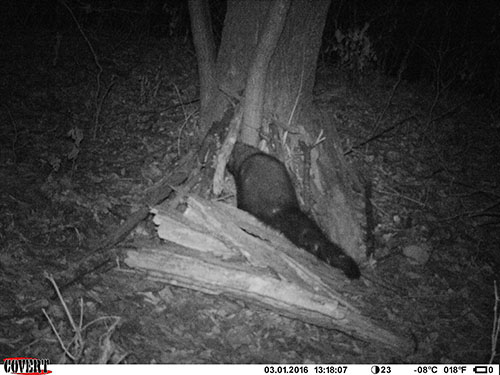
Photo credit Jeffrey Miller.
There were no coyotes on the camera a week later, but the “black cat” was back. It had found both baits and eaten every scrap of meat off of them. The fisher season had closed at that point, but the wheels began to turn in my head.
Fishers are said to be animals of large forests, preferring the coniferous habitat of the North. They prefer areas with large trees for dens, as well as the canopy cover the trees provide. The high canopy closure is important. The thickness of downed trees and brush also provide habitat for the prey species the fisher prefers, such as rabbits, squirrels and porcupines. With partially retractable claws, fishers have no problem climbing into trees to hunt down prey.
The landscape around my rural North Dakota home is typical of farm country. Farm fields stretch to the horizon, broken up by tree rows and farmsteads. The monotonous countryside is crossed by prairie rivers snaking through the land. Lush forests of deciduous trees line the riverbanks, providing heavy cover. Oxbow lakes, formed when the river changed course, are numerous.
At first it was hard to believe that fishers inhabit farm country. But after talking with trappers from the Upper Midwest, it turns out that fishers have been colonizing areas that have never seen them before. As with any wild animal, there are no absolutes. Fishers have proven to be quite adaptable animals, learning to live in the edge habitat of farm country. Not only is it incredible to see one in the wild, it offers another trapping opportunity.
My trapping mentor, Pat Grumley, was the first trapper I knew that was successful in harvesting a fisher. He and his wife, Toni, caught one in a cubby box in 2016. Since I tan hides at home for my side business creating fur hats and mittens, Pat asked me to tan the hide for them. I was amazed by the beautiful coat. The trail camera pictures I had of fishers made them look all black. But up close, the black on the back end of the animal segued into a grizzled brown on the head and shoulders. Splashes of white were painted on the belly and chest. I knew at that point that I needed to catch one for myself.
Since most of the information that I found was on trapping fishers in their common boreal habitat, it was hard to translate to the open country of eastern North Dakota. Even where fishers are common, they are never numerous. Except during the brief breeding season, they are solitary animals with large home ranges. In the open country, that range is even larger given the more limited habitat. A fisher here today may not come back for weeks. Pat made the point that because of this far-ranging behavior, prebaiting is the key.
My friend Lynn owns a beautiful piece of land just north of my homestead and had given me permission to trap on it. I had already collected a gorgeous raccoon and a beautiful red fox there, and had my sights set on catching my fisher there, as well. In fact, I had even caught a fisher near the oxbow during the fox trapping season in a hay set. Unfortunately, the season had already closed, and I had to release the beautiful animal. Being so close to the remarkable animal made the fire burn brighter. With no other trapping competition and wonderful habitat, I hoped to draw the far-ranging animal to the bait.
Lynn calls it “The River Farm” for good reason. Bordering the river is a thick forest of American linden, box elder, bur oak, cottonwood and hackberry. The oak trees and cottonwoods have grown to gigantic proportions, with plenty of holes for dens. Most appealing to the trapper, however, are the two oxbow lakes that are adjacent to the river. Cut off from the current, the oxbow lakes have a mind-boggling array of biodiversity. Everything from frogs to fish to invertebrates live in and around the oxbow lakes. The lakes funnel animal movement through the otherwise flat forest and fields. Even the surrounding farm fields provide good habitat, as Lynn is a no-till farmer. He doesn’t work the ground after harvest, and the residue from the season’s crop provides a plethora of habitat for everything from mice to deer.
The first course of action was getting baits out. Following a successful bow hunt on the home farm in Minnesota, I had saved the hip bone of the deer. Since I was going to place baits on the north and south sides of the 3-acre oxbow lake, I saved a couple of raccoon legs for the other bait. I wanted to see if the fisher preferred one bait over the other. Trail cameras would aid in identifying a furbearer checking the baits.
The land funnels off to a spit of land less than 20 yards between the river and oxbow on the north end. Box elders grew in profusion, and I selected a leaning box elder for the running pole set. After wiring the deer bone firmly to the tree, I covered it with some branches to hide it from birds. Above the bait on a tree branch, Caven’s Gusto Long Range Call scent was smeared. Near the base of the tree, I placed some Caven’s Tree Climber lure.
The second bait was placed on the south side of the oxbow, where the lake drained into a small stream. Instead of another running pole set, I built an elaborate cubby out of limbs and bark from a downed tree. The back of the cubby was placed against an American linden tree. After wiring a raccoon leg to the tree, the cubby was built in the shape of a V. I again used Gusto on the tree above the cubby and Tree Climber on a stick. The stick was tossed to the back of the cubby, completing the set.
A week later, on the opening day of the fisher season, I was back. Accompanying me was my significant other’s 4-year-old son Carter. Excited to show him some fisher pictures, I hoped the baits had been hit.
The cubby set was in shambles. Something had not only broken it down but had absconded with the raccoon leg. To say I hurried to fire up my mobile phone and check the SD card from the camera would have been an understatement. Carter was excited to see picture after picture of a beautiful fisher. The animal had visited the cubby three times in seven days. He was successful the last evening in removing the bait from the wire. Carter and I rebuilt and baited the cubby, adding an H-stand and a 220 Conibear to guard the opening. Adding more Gusto, the smell of skunk drifted heavily in the still November air.
The fisher was also photographed on the running pole set, along with a raccoon and plenty of mice. He was quite acrobatic, requiring me to block off the underside of the tree with some additional branches. With a few nails I attached the 220 trap directly in front of the bait. Carter and I further explored the forest on our walk out, digging a few dirt holes for raccoons. I was very optimistic on the short drive home.
Two days later I was back. I had been told by numerous experienced fisher trappers that patience was the biggest virtue, but, given the trail camera evidence, I was sure there would be a fisher waiting for me. Nearly sprinting to each set, I was disappointed to see them empty.
The same empty traps greeted me the next day. Not only is the season a short seven days, but the weatherman was predicting a blizzard for the upcoming weekend. The sands in the hourglass were disappearing rapidly.
Thanksgiving morning dawned cool and clear. After getting the kids set up with breakfast and before putting the bird in the roaster, I made the quick trip four miles north to check the sets. The excitement that had built the first few checks was starting to lag.
My initial thought when I saw the cubby broken apart was that a raccoon had gotten into it. My mind didn’t immediately register the presence of a long black tail buried in the woody debris. After quickly digging out the debris, I had my hands on the large mustelid. My first fisher was a beauty.
While someday I’d love to chase fishers in their traditional big-woods habitat, it’s a testament to the adaptability of the species that the farm country trapper can catch the beautiful “black cat” on their home turf. By scouting to find locations the animals frequent, using bait in the preseason and a dash of luck, this wonderful furbearer can be added to the trapper’s fur board.
